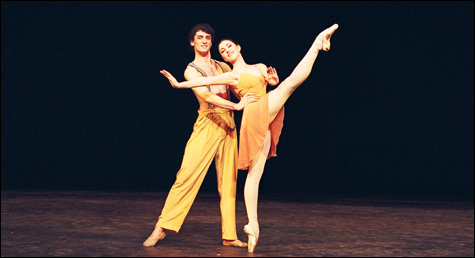
SECOND BEFORE THE GROUND: Lasha Khozashvili, Nino Gogua, and the rest of the company
relaxed into Trey McIntyre’s ballet.
|
In the late 1980s, the Iron Curtain began to part, and Nina Ananiashvili was one of the newly hatched wonders the Bolshoi Ballet was able to show off to the West. Boston audiences first saw her in 1990, as part of Boston Ballet’s “glasnost” Swan Lake; she was paired with the late — and truly great — Boston Ballet principal Fernando Bujones, then 37 and at the height of his artistic maturity. Two years later, she was back to dance Odette/Odile with a familiar partner, Alexei Fadeyechev, and her promise of stardom shone brighter still. Arlene Croce, the venerated — and famously crusty — former New Yorker dance critic, was singing her praises as early as 1987: “Ananiashvili deserved her publicity. . . . Probably, she can do a lot more than she knows.” My own Boston Phoenix review (May 8, 1992) of that second set of performances seems like a time capsule set to be opened for her appearance at Jacob’s Pillow last weekend: “ . . . these young couples are the future now; in 15 years, they will be held in the same aura of awe and respect as Natalia Makarova and Fernando Bujones, or Gelsey Kirkland and Mikhail Baryshnikov.”
The Georgian-born Ananiashvili came to the Pillow with the company she is now directing, the State Ballet of Georgia, after years of performing with companies around the world, notably American Ballet Theatre (where she’s still on the roster) and the Royal Ballet. This is a pattern that other dancers — in particular Soviet-bred dancers — have embraced, but the question remains whether all the globetrotting is a good career move. The lack of regular association with a ballet company can lead to a lack of name recognition: to many balletomanes Ananiashvili is a goddess, and yet the audience at the Pillow’s intimate Ted Shawn Theatre was sparse. And there’s a more troubling issue, one that Croce addressed in 1996, in an essay in which she compared New York City Ballet star Kyra Nichols — who by staying with NYCB “ripened on the vine” — with dancers such as Ananiashvili: “ . . . the disaffiliated ballerina — the dancer who seeks artistic completion by freelancing or by guest-starring all over the world.” Croce’s assessment? “Of the generation of ballerinas born by the end of the sixties, Kyra Nichols is the only one with a completely formed, articulate technique and a distinguished repertory in which to deploy it.”
Which is a roundabout way of admitting, with a heavy heart, that it was not a big fat treat to see Ananiashvili perform last Saturday. Why must she choose, of all things, to perform in the Don Quixote pas de deux, one of the more demanding pieces from the classical repertoire? And this was the only piece she appeared in. Mikhail Baryshnikov, who’s 15 years her senior, continues to enjoy a performing career because he makes realistic choices. Former ABT ballerina Martine van Hamel is another mature artist who, the last time I saw her perform, looked fabulous dancing in pieces less exacting — though not necessarily less strenuous. Ananiashvili is probably still a gorgeous mover who could be stunning in more-contemporary pieces — but it seems she isn’t letting go yet.
And the State Ballet of Georgia? I’d call it a second- or maybe third-tier ballet company. In addition to the mish-mash of excerpts from Don Quixote called the Don Quixote Grand Divertissement, the program consisted of George Balanchine’s 1981 work Mozartiana (though born in St. Petersburg, Mr. B was of Georgian heritage) and Second Before the Ground, which Trey McIntyre choreographed for Houston Ballet in 1996. The irony is that it was Mozartiana in which the company looked least comfortable. Set to Tchaikovsky’s Fourth Orchestral Suite, this is another of Mr. B’s delicious “who needs a plot when there’s this much enigma in the steps” ballets. But there was too much enigma for most of the dancers, who failed to find either natural expressions — somber became mouth drawn down and eyebrows melodramatically pinched together; happy became a fleetingly nervous smile — or an ease, a fullness, in the choreography. The two men, Lasha Khozashvili and David Khozashvili, in particular struggled to find a balance between playful, mincing petit allegro and bounding grand allegro, seeming never to leave the ground for either. Yet they both looked technically capable, and David Khozashvili confirmed that impression in the rest of the program. The lead woman, Nino Gogua of the lovely legs and feet, is talented young dancer, but it seemed that each movement was approached with held breath and suspended belief — “Wait, I’m going to do a piqué arabesque here” — followed by relieved exhalation — “Ah, look I did it . . . now on to the next step.” Much of the ballet felt like that: chopped up and endured with stoicism.